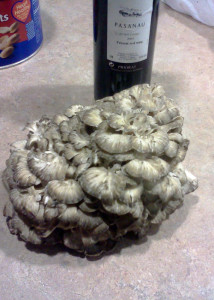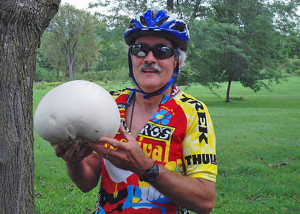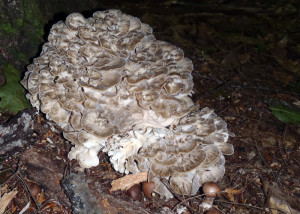
Too much rain can literally dampen a lot of outdoor fun, but it does have one major side benefit: mushrooms sprouting everywhere! Here at EasternSlopes.com, where most of us like to cook and eat almost as much as we like to play outdoors, hunting edible mushrooms is one of our favorite excuses for getting outdoors and having fun.
A lot of folks get a little queasy at the thought of picking and eating wild mushrooms, believing they are going to die a slow, agonizing death if they eat any mushroom that doesn’t come wrapped in cellophane at the supermarket. Well, yes, as a matter of fact, that is exactly what can happen if you aren’t careful. Some of the most enticing mushrooms to look at, are among the deadliest. Some innocent-looking little mushrooms could send your mind exploring alternate universes. And some of the best edibles look like they could kill you. Go figure . . . ?
How To Get Started Picking Wild Mushrooms
If you want to be absolutely 100 percent safe, don’t eat any wild mushroom, ever. But what fun would that be? If you are cautious in your approach, learn to identify a few species that can’t be mistaken for anything else, and pick and eat ONLY mushrooms you know, you can safely enjoy eating wild mushrooms. Many of us have done it for decades with no ill effects and none of us are true mushroom “experts”; rather, we are just people who love to eat mushrooms and have learned to pick with caution so extreme that it borders on paranoia. Among us, we currently have a dozen or so mushrooms (of the many hundreds or even thousands that grace the New England landscape) that we’ll pick and eat. These tend to be unmistakable varieties, or ones that we’ve been taught to recognize by real experts.“When in doubt, throw it out.”

While mushroom hunting is a great excuse to get outdoors and go exploring, we sometimes find our best mushrooms while we’re doing something else. Some of us have been known to spot a good cluster of Oyster mushrooms (Pleurotus ostreatus) while driving a highway at 65 miles per hour . . . . And, when it’s safe to do so, we’ve been known to slam on the brakes, pull over and harvest them.
We’ve also been known to spot edible mushrooms on people’s lawns, or on the trees in front of their houses and stop, knock on the door and ask permission to pick them. Yes, we get some strange looks sometimes, but people are usually very nice about humoring us. And, best of all, they almost always refuse when we politely offer to share.
But hiking is usually a far better way to find most mushrooms, especially some of the smallest, choicest varieties like morels and chanterelles. You can sometimes find edibles along trails—keep your eyes peeled. But think about it. Mushrooms often grow in the same general area year after year. One person sees them growing along a trail and comes back year after year. Good for them, not so good for you. The best way to find mushrooms is to go bushwhacking in areas where other people rarely, if ever hike. In other words, “Go find your own mushrooms!”
David Shedd, the publisher of EasternSlopes.com, and Tim Jones, the executive editor always take at least one hike a year with the specific intention of finding edible mushrooms. They mainly look for the “Hen Of The Woods” (Grifola frondosa) which is pretty common in rainy fall weather, but various Boletes, Chantarelles and of course, Oyster mushrooms (which also like rainy fall weather) are also on the menu. Typically, they’ll find lots and lots of mushrooms that certainly look edible. But if they aren’t 100 percent sure what they are, they’ll leave them in the woods. “When in doubt, throw it out.”
You don’t always have to take long hikes. Last fall, for example, Tim found a large cluster of Golden Chanterelles (Cantharellus cibarius) and several very choice large King Boletes (Boletes edulis) on his daily stroll down the driveway to the mailbox. Correspondent Susan Marean Shedd seems to have a knack for finding Hen Of The Woods in her neighborhood back yards.
Just learn to identify a few edible mushrooms, always have a knife and some plastic bags handy, and then keep your eyes open as you have fun outdoors.

Pedal-powered Mushrooming
Last fall’s mushrooming season began with a tremendous find. As Tim tells it: “My sweetheart Marilyn and I were riding our tandem bike near Lake Champlain with Vermont Bicycle Tours. This was four days after Hurricane Irene had dropped flooding rains. One day, we took a ferry ride across Lake Champlain to visit Fort Ticonderoga. While pedaling the access road to the fort, I spotted what looked like a soccer ball in the middle of a lawn and stopped to investigate. It turned out to be the largest giant puffball mushroom (Calvatia gigantea, which some mushroom books describe as ‘edible, choice’) I have ever seen. I might not have seen it from a car, but it was hard to miss from a bike. It was absolutely perfect, still firm, not an insect hole to be seen. So I collected it and handed it to Chip Martin, the tour guide driving the sag wagon for VBT, who had come along at just the right moment.
The next morning at breakfast, Dominic Francis, the chef/owner at Shoreham Inn where we were staying presented our group with a huge platter of puffball done in three styles—grilled, deep fried and sautéed. Everyone at least tried it; I think everyone liked it. I know I sure did. It was one of those special moments that captured the pure joy of finding edible mushrooms.”
Learning Fungi: When in doubt, throw it out

The web is loaded with so many resources on mushrooms that it can get confusing. If you know nothing about the subject, try starting at http://ediblewildmushrooms.com/ from Forager Press, which publishes a number of good mushroom guides. This site gives you five good mushrooms to start with. Add the Giant puffball and Oyster mushrooms and you are well on your way to becoming a proficient collector. Another online resource we’ve used is Mushroomexpert.com.
If you really want to learn mushrooms, however, join a club: You can usually find a local group if you look hard enough—though mushroom hunters are sometimes as elusive as Morels (a particularly tasty but hard-to-find mushroom species that comes out in the spring).
The Northeast Mycological Foundation has an extensive list of local clubs, as does Mushroom, The Journal of Wild Mushrooming. In addition, The Connecticut/Westchester Mycological Association, The Boston Mycologial Club, and The Berkshire Mycoligcal Society all sponsor regular walks, and there are many others.
Among experts, you’ll learn to see mushrooms you’d miss otherwise. You can put names to them. Learning to name some fuels your desire to learn more. Just remember, when picking mushrooms to eat, the rule to live by is “When in doubt, throw it out.”



The best producing hen of the woods tree in maine is located at the Spirit Pond Preserve Phippsburg land trust trails in Phippsburg maine.
the coordinates are approximately: 43.751511, -69.807439
Spirit Pond Hen Of The Woods Red Oak Tree Map Link:
https://goo.gl/maps/xav2jNiw9u82
every single year this ancient red oak produces at least 50 pounds of prime grade A hen of the woods, maitake, grifola frondosa, g. frondosa mushrooms! Hen of the woods seems to be independent of drought conditions. Though after years of hen hunting, I have only found hen-of-the-woods mushrooms within 200 feet of water, whether that be salt water or fresh water, or brackish water. Often times the old oaks where they are found are immediately on the edge (even overhanging) of a body of water, and frequently near tidal areas along the coast of maine.
The Spirit Pond oak tree produces from the middle of September to the middle of October every single year, and has done so for at least the last 15 years and probably longer. The tree is located toward the beginning of the spirit pond trail and about 200 feet from spirit pond at the site of an old homestead and near the spirit pond burial ground. the tree fell directly over a portion of the trail in 2015 but still grows hen of the woods mushroom from the remaining stump, around the stump and from the base of the fallen tree itself in huge numbers and size. Check this tree frequently during the season as it is well known locally to grow hens.
Where to find the second most productive hen of the woods oak tree in maine is at the Center Pond Phippsburg land trust trail in Phippsburg maine. It is located at the edge of center pond just opposite the beaver pond along the main trail.
Center Pond Phippsburg Maine Hen of the Woods Map Link
https://goo.gl/maps/6RM8cur8mio
43.809922, -69.815736
The preceding geo-location in this instance is exact. The fallen trunk of this tree can be seen on google maps satellite view. This grifola frondosa supporting red oak tree has grown mushrooms as late as mid November and particularly on, and inside the hollow portion of the fallen tip-over dead section which actually rests in Center Pond itself.
The hen of the woods that this tree produces range from 10 – 20 pounds. this tree is easily accessed and well known, so the maitake go quickly. if you’re the lucky one to get a 15 pound hen of the woods from this tree, you’ll understand why it’s called the dancing mushroom.
Chicken of the Woods Locations at Spirit Pond Phippsburg Maine
There are also huge amounts of chicken of the woods mushrooms near the same trail locations growing on old and fallen oak trees. They grow randomly between mid June through the end of October, with fall production being the greatest from September through October.
Honey mushrooms are also found frequently at the same oak locations in October on the dead oaks and on the roots of living oaks.
Chanterelles may be found at spirit pond in July and August. Boletes are profuse around labor day weekend
https://goo.gl/maps/fhMLGsuWmxr
43.752408, -69.806937
https://goo.gl/maps/cNAj8TPVc5p
43.750986, -69.807275
https://goo.gl/maps/dvHmkXpNwUn
43.751461, -69.808005
https://goo.gl/maps/4zmGpaCoi2q
43.749886, -69.811110
https://goo.gl/maps/t75ubQYnyTM2
43.748844, -69.811986